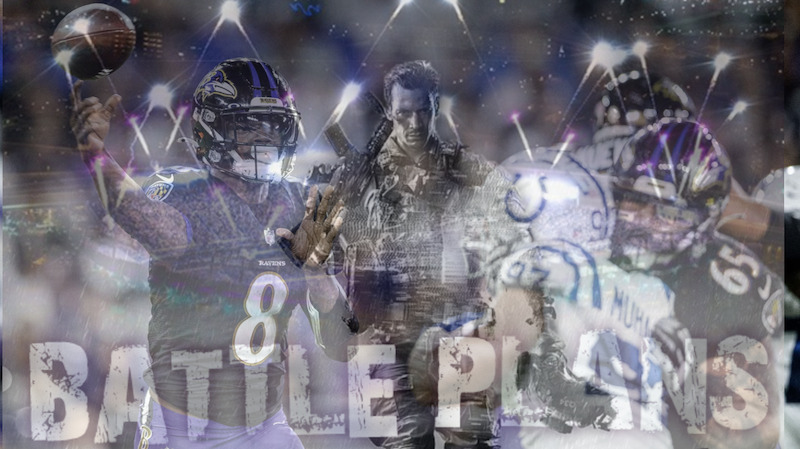RSR’s Dev Panchwagh and Nikhil Mehta are teaming up to bring you BATTLE PLANS in 2023.
Offense
Running the Ball From Under Center
Baltimore’s offensive line opened up huge creases for Gus Edwards against Cincinnati, who had an astounding 0.50 EPA/rush despite facing a heavy box on 70 percent of his rushes. His role is likely to increase with Justice Hill dealing with turf toe, which will affect how the Ravens line up on offense. Hill takes a vast majority of his snaps lined up next to Lamar Jackson in the shotgun, while Edwards is usually a single back, either behind center or in the pistol.
If Hill can’t go on Sunday, Melvin Gordon will step up as the Ravens’ third-down back, but they may not operate out of shotgun on early downs as often so they can get Edwards on the field. Like most defenses, the Colts match 11 personnel with five defensive backs, so rolling out three wide receivers but operating under center could give Edwards lighter boxes to work against.
It’s not as simple as just running headfirst into the Colts’ stout defensive front, though. They lean on Shaquille Leonard, DeForest Buckner and Grover Stewart to anchor the middle so they can devote more numbers to coverage. As a result, the Ravens will have to attack the edges of the Colts’ DL without their best zone rushing personnel, but they can still run some stretch plays to attack the perimeter, while mixing in counters to catch the Colts off-guard. Mixing in counter runs along with jet motion from wide receiver Zay Flowers will force the Colts to protect the edge and open up space on the inside.
Play Action to Slow Down Pass Rush
Operating under center doesn’t mean the Ravens only have to run the ball. The Colts have the second-lowest blitz rate in the NFL, and while that is based on a small sample size, it’s still a fundamental part of their defensive philosophy. That will afford Jackson the time to execute more play action, an easy way to help out his banged-up offensive line. Monken can use pullers to move the pocket, which will specifically help center Sam Mustipher when he matches up against Buckner, one of the best interior pass rushers in the NFL.
Todd Monken also designs his run game to pair with his play action very intentionally. He’ll show a particular blocking scheme with a few different rushing variations, then dial up a play action that looks the exact same. The defense’s odds of guessing right are lower; instead of picking between run and pass, they have to be prepared for multiple run concepts plus a potential pass.
By operating from under center, the Ravens can force the Colts’ linebackers to get more involved, which will open up more room over the middle of the field against Gus Bradley’s Cover-3 heavy scheme. If you read ‘room over the middle of the field’ and think Mark Andrews, you’re not wrong. Expect to see him sell a run block before releasing into the seam to exploit the space behind the linebackers and in front of the single-high safety.
Monken can also target that space with dig routes from Rashod Bateman and Nelson Agholor off play action.
Calculated Shots Downfield
While the Ravens could have success on the ground, the Colts have only allowed one explosive rush play all year. When Baltimore wants to pick up chunk yardage, they’ll likely need to do so through the air. Taking shots off play action is one way to do that, but there are plenty of ways to exploit Cover 3 downfield with a traditional passing attack.
Let’s start with the obvious: 1-on-1’s down the sideline. The Ravens finally have the receivers to stress defenses vertically who can release off the line of scrimmage and win at the catch point. Even with OBJ sidelined, Bateman and Agholor have contested catch skills, and Flowers proved last week he’s no slouch, either.
But throwing go balls, while fun, isn’t actually scheming up explosive plays. Instead, Monken can use variations of route combos that he’s already shown that will stress the rules of Bradley’s match coverages.
Take Zay’s post routes, for example. Against Cover 3, his speed will put the Colts’ deep middle safety in a bind: leave Zay 1-on-1 against unproven corners or vacate the middle of the field. Running a high-low concept off that post route with Andrews finding space behind the linebackers will give the Ravens multiple options for chunk yardage on the same play.
A variation of this look from the Dolphins could also be deadly.
Cool way of getting to verts especially against stubbie types of coverages with the corner 1-on-1 on the outside. Berrios runs a whip wheel.
Misdirection for the CB but also makes the throw easier on the QB. pic.twitter.com/DM4lLBZqxw
— Ted Nguyen (@FB_FilmAnalysis) September 18, 2023
The slot-fade clears out the boundary corner and gives the whip-wheel the outside leverage to accelerate away from the nickel defender up the field. This works especially well for the Ravens given Flowers’ success in getting open on slot-fades already this year. The Colts will have seen those plays, so adding the whip-wheel wrinkle effectively uses their preparation against them.
Defense
"Ain't too many hunters left."@RayLewis mentoring Roquan Smith in the film room is too cool 🙏 @Ravens pic.twitter.com/eBZ9o8r7aV
— NFL Films (@NFLFilms) September 22, 2023
Disguise, bait and switch
It looks like Gardner Minshew will get the start for the Colts with Anthony Richardson still sidelined by a concussion. He has that backup gunslinger mentality, so if he sees – or thinks he sees – an opportunity downfield, he’s going to take it.
The Colts WR threats of Michael Pittman and Alec Pierce may not be as formidable as the Bengals’ group, but they fit similar molds in how they can threaten offenses vertically. The Colts also have a miserable 4.92 average depth of target thus far this season, with Richardson comfortably taking his first open read underneath instead of trying to push the ball downfield. That’s not Minshew’s game; he wants to ball out and take shots.
Baltimore should invite that. They ran disguised coverages to perfection against the Bengals, using split-safety pre-snap looks to discourage Cincinnati sideline shots before rotating to close the middle of the field post-snap. Geno Stone’s interception came off of one such play, perfectly baiting the throw to the middle of the field to rob the Bengals of what looked like an easy TD.
This is a such a great play from Geno Stone
At the snap, Joe Burrow briefly identifies Stone as he’s drifting towards Ja’Marr Chase
Once Chase releases outside, he immediately breaks towards the
middle of the field, and is in perfect position for the INT pic.twitter.com/ij633Q2XiX— Kevin Oestreicher (@koestreicher34) September 18, 2023
This was positively Ed Reed-esque. Stone knew what was going to happen the whole play, cheating towards the middle after initially dropping into a deep half zone, but didn’t break for the ball until Burrow committed to the pass.
Look for Mike Macdonald to deploy Stone in a similar way on Sunday, but with some variations. They could reverse the above play for example, with Stone showing a single-high look with Hamilton in his overhang/star alignment before both of them snap back into Cover 2 post-snap. That could draw an easily interceptable pass up the sideline from Minshew, who might think he’s got a friendly 1-on-1 outside matchups pre-snap and commit to taking a shot down the sideline.
Attack the Interior
Richardson isn’t the only key absence for the Colts. They’re also missing center Ryan Kelly and guard Quentin Nelson, giving the Ravens an opportunity to generate pressure on the interior.
Baltimore’s defensive line should be able to win some matchups there, but on key downs, Mike Macdonald should design pass rush concepts to target that interior weakness.
The Colts will likely use double teams to deal with the size and power of Michael Pierce and Travis Jones on the interior, so kicking Jadaveon Clowney inside – which is something he has done in his career — will give him some 1-on-1 matchups against a guard. That sounds like a recipe for pressure.
Macdonald can also deploy some twists and loops, testing the backup Colts OL to pick up and pass off rushers in a synchronized way. Odafe Oweh has been crucial to Macdonald’s line games thus far this year, so David Ojabo could take on some of that role if Oweh is too banged up, looping inside as the interior stunter clears the way.
Filling the Slot
It’s disappointing that Ar’Darius Washington had to go on IR before this game, as he would have been a fun matchup against Colts slot receiver Josh Downs.
Washington’s injury also extends what is now a long-running issue for the Ravens: stability at slot corner. Arthur Maulet has been a healthy scratch for the first two games, but Baltimore kept him on the roster for a purpose: reliable play in the slot.
Maulet’s short-area quickness and physical, willing play against the run is an easy fit into this Ravens D. As a veteran, he should slide in fairly smoothly, taking on Washington’s basic nickel responsibilities in the secondary, including blitzing from the slot.
However, there’s also an argument for getting your five best (healthy) DBs on the field at the same time, and based on his performance last week, Brandon Stephens is in that group. Keeping Stephens on the field instead of Maulet means either Stephens, Ronald Darby or Kyle Hamilton will have to take on some slot duties.
Unfortunately, there are challenges with all three. The Ravens seem to want Hamilton to play a less-defined safety role instead of the nickel, and Darby has barely lined up in the slot in recent years. Stephens looked good at nickel in training camp, but now that he’s playing his best ball on the outside, does it make sense to move him?
Having Maulet as the default slot option therefore feels like the right play, with room for Macdonald to deploy Hamilton, Stephens and Darby in certain matchups and coverages, especially in third-and-long situations where they need to defend further down the field.
One-on-One Matchup to Watch
Shaquille Leonard vs. Mark Andrews
Mark Andrews immediately made his presence known upon his return last week, with three of his five receptions going for a first down, plus a fourth in the end zone. Now fully healthy, he’ll likely face Shaquille Leonard in all phases of the game.
Leonard is a particularly tough matchup not because he’s a man-on-man tight end eraser, but rather because of his spatial awareness in the middle of the field. He knows where offenses will try to attack, and even if he can’t shut down every throwing lane, he makes them all much tighter. Andrews will have to be more precise with his depth and spacing, not just to stay out of Leonard’s range, but also in relation to the Ravens’ other routes on the play.
Andrews can also play a role in getting Leonard out of position on play action. The better Andrews can sell his block before releasing, the more room the Ravens can exploit behind Leonard downfield.











